Yahoo’s Gemini marketplace for mobile and native ads launched in February and is now the default audience option in the Yahoo self-serve advertising manager. But what is Gemini and how does it work?
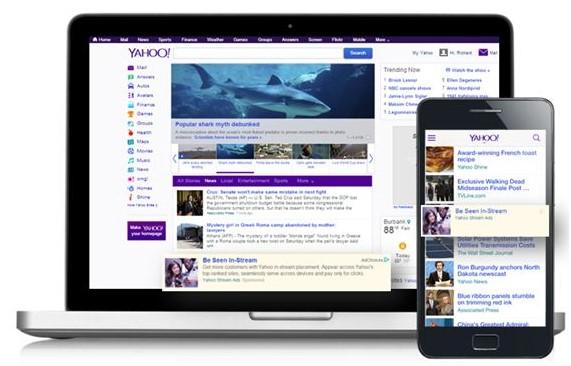
Yahoo Ad Manager launched in January as a simplified platform for advertisers to buy and manage native ad products like Stream Ads, Image Ads and sponsored Tumblr posts. Gemini was added to leverage the power of mobile and native advertising together; their native ads are optimized for tablet and mobile devices.
Yahoo Gemini powers native ads that put sponsored brand content in front of Yahoo’s 400 million monthly users in contextually relevant ways.
But First…Why Native Ads?
If you’re not yet familiar with the format, native advertising is the increasingly popular method of reaching audiences with contextual messaging that appears alongside – or in-stream with – editorial content. Some describe it as a subset of content marketing; others as content’s “sponsored twin.”
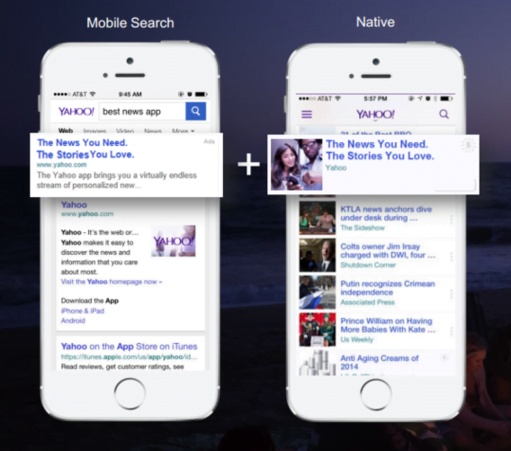
Whatever your definition, native advertising has proven incredibly effective, especially against more traditional web advertising formats. A Sharethrough study, for example, found that people were 25% more likely to look at native ads than banner ads and viewed them 53% more frequently. Participants in that study were also more likely to share native ads with their contacts and demonstrated greater purchase intent after viewing them, compared to other types of ads. In the U.S., almost three-quarters of publishers already offer native advertising on their sites.
In their presentation Yahoo Gemini Vision & Impact, Yahoo shares a number of other stats on native advertising:
- Perceived effectiveness is fueling marketer investment in native ads, up from $1.4B in 2012 to $3.1B in 2014.
- Only 4% of marketers say they’re completely satisfied with their mobile ad campaigns.
- 95% of digital advertising pros buy mobile ads.
- Investment in native ads is expected to rise to $5B a year by 2017.
Despite their omnipresence and enthusiasm among advertisers, 85% of consumers have never even heard of native ads. The FTC has been clear in their position on clearly marketing native advertisements as such, yet only 79% of advertisers understand that native content must be identified as advertisements. Clearly, it’s a format with opportunity, yet there is much to be learned.
What Is Yahoo Gemini?
Yahoo’s Gemini offering helps advertisers reach mobile consumers in a contextually relevant, effective way: through native ads tailored for mobile. It’s a marketplace worth considering; Yahoo has more than 430 million monthly mobile users who average 104 minutes per month.
Where Google consolidated desktop and tablet paid search with the introduction of Enhanced Campaigns, Yahoo is offering advertisers the ability to manage mobile and tablet ads from a separate interface with Gemini. This is an opportunity to get more granular with your search strategy.
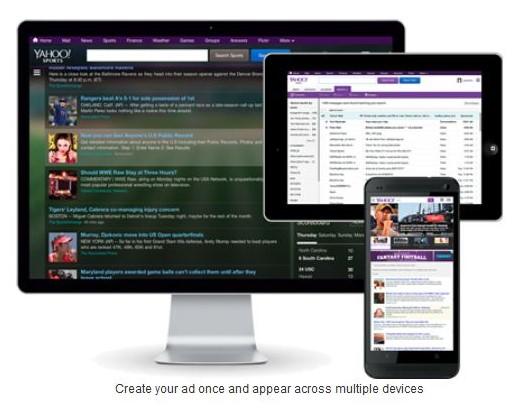
Image from Yahoo
Gemini advertisers have targeting options including geotargeting, broad and exact match, and negative keywords. They plan to offer sitelink, location and call extensions; phrase match; day parting; and device, language, radius and operating system targeting in the future.
Currently, Yahoo is in the process of rolling the ads out to greater audience segments. In March, just 1% of mobile search traffic would see Gemini ads, though they planned to increase in April and beyond. Yahoo plans to have all accounts migrated and set up in Gemini by April 30.
Yahoo’s native ads appear on the Yahoo homepage and in the following Yahoo products: Mail, Mobile Search, News, Sports, Finance, Celebrity, Movies, TV, Music, Travel, Homes, Autos and My Yahoo. Ads automatically adapt to the device type, whether computer, mobile or tablet.
How Does Gemini Work With Bing Ads?
It doesn’t. Currently, Bing Ads campaigns are incompatible with Gemini, which is proprietary to Yahoo and built on a separate codebase.
Bing offered this explanation of the impact of Yahoo Gemini on Bing Ads:
“Bing Ads provides search ads on all devices, including mobile devices, across Bing and Yahoo search results pages, as well as our network of partner sites. Only a portion of search ads on Yahoo’s mobile search pages will be provided by Yahoo Gemini instead of Bing Ads. Bing Ads remains the only platform for purchasing mobile search ads on Bing and its network of partner sites and also delivers search ads on the highest performing mobile search placements (i.e., topmost on page) for web searches on Yahoo’s mobile search pages.”
In case that wasn’t clear, Bing’s FAQ page on Gemini also says,
“Bing Ads is the only unified platform for advertisers to manage paid search advertising across all devices including PC, tablet and mobile devices, in order to achieve scale across the entire Yahoo Bing Network.”
According to Adotas, Gemini ads will appear on more partner sites over time, while Yahoo will work to create parity between Yahoo Search Ads and Bing Ads.
How Do You Create Ads & Campaigns in Yahoo Gemini?
1. Start by signing in to the Yahoo Ad Manager. If you don’t yet have an account, you can easily create one, or log in using your Google or Facebook account.
2. Click ‘Campaigns,’ then ‘Create a Campaign.’
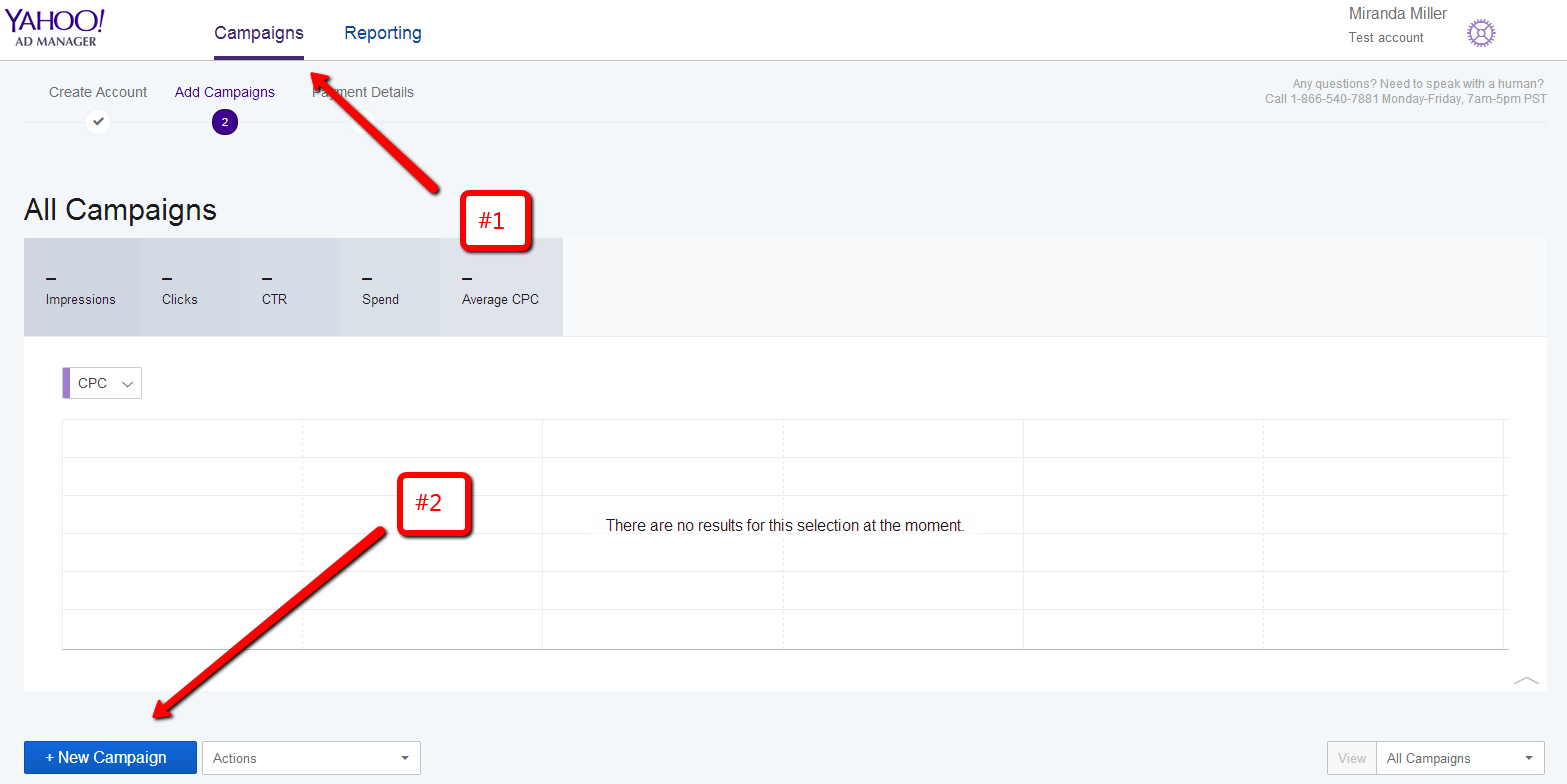
3. Create your ad. For each ad, you’ll need:
- An ad title of up to 50 characters.
- An ad description of up to 150 characters.
- Your landing page URL.
- Your company name, up to 25 characters.
- Your display URL.
- An image – for text ads, Yahoo recommends that you use a high-quality image with an 82×82 or 1:1 ratio. For image ads, you can either link to an image or click the camera icon to upload one. Yahoo recommends that images for image ads are 1073 pixels wide by 715 pixels high.
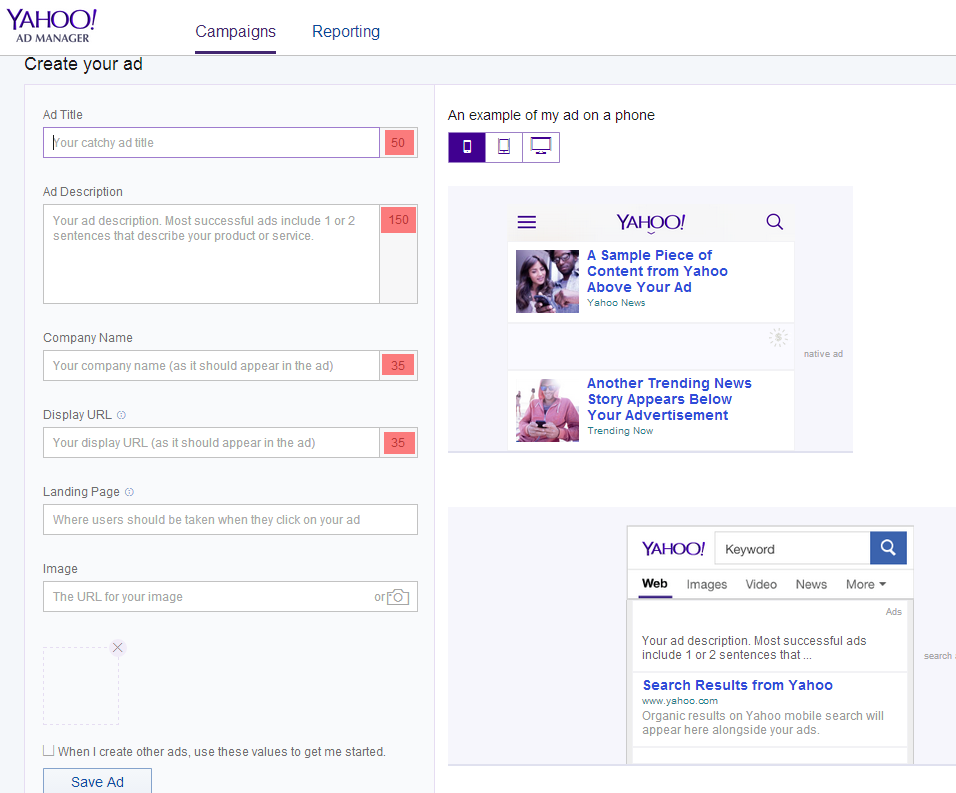
You’ll be able to preview your ad on the right as you create it. Once you’ve added the information above, click the checkbox to indicate whether or not you want to use the ad information for additional ads.
Click Save Ad to save it in the My Created Ads section of your dashboard.
4. Define your audience. Start by clicking on Advanced Settings, Suggest keywords and ‘Modify’ as indicated below, to see all of the options available to you.

Now, it’s going to look more like this:
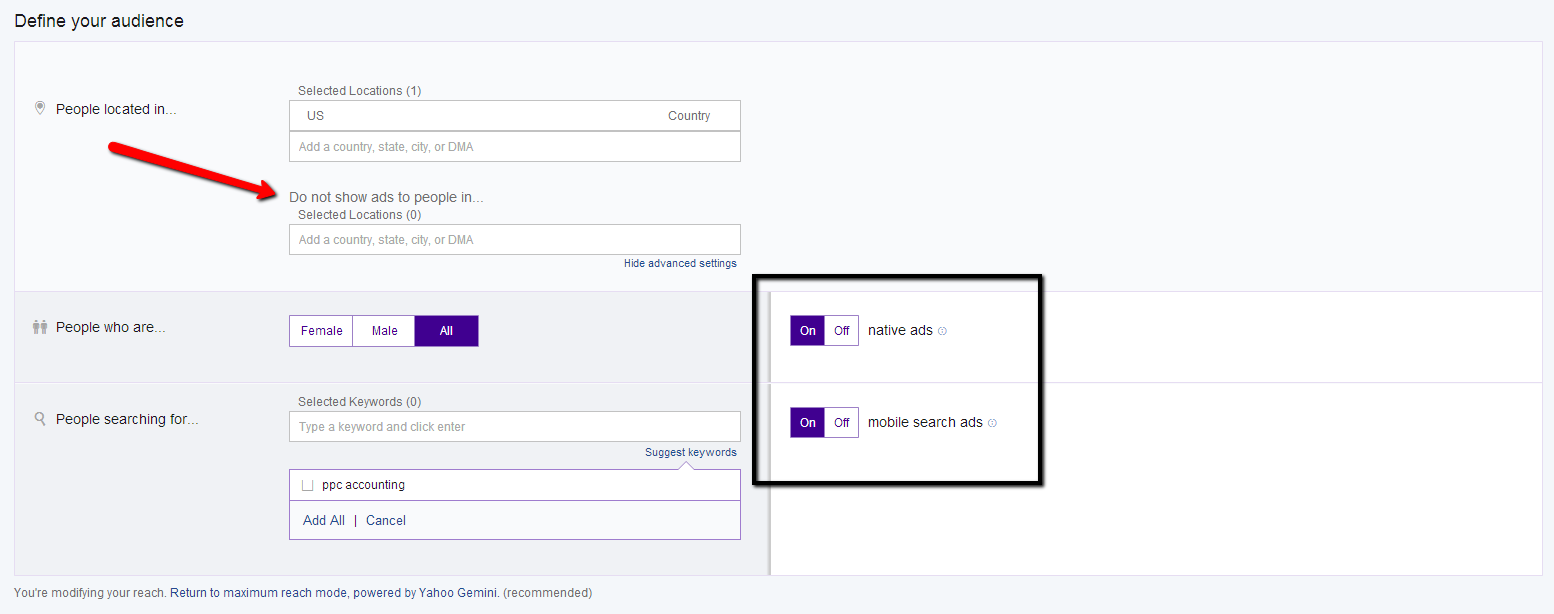
In addition to targeting people in specific locations (country, state, city or DMA), you can indicate areas where you don’t want your ads to show.
Yahoo will warn you that Yahoo Gemini native ads and mobile search ads give you maximum reach, but if you want to turn one or the other off for some reason, the option is there.
5. Set your bids. By default, Yahoo allows you to set your maximum cost per click – that is, the maximum you are willing to pay for each click. However, if you look to the far right, there is an option for Advanced pricing.

If you open advanced pricing, you’ll have the option to set different maximums for Yahoo native and Yahoo mobile search ad formats.

You can then set a daily budget, or a budget for the life of the campaign. Choose to run ads immediately, or set a start and end date.
6. Name and save or start your campaign.

7. Set up payments. Before you can start your first ad campaign, you need to fund your account.
You’ll need to add a minimum of $25.00 to your Yahoo advertiser account. On the first page of the set up payment section of the site, Yahoo has Autoload set as the default option; basically, it tops up your account by withdrawing from your credit card or bank account when your balance is below 10% of the reload amount you indicated.
If you don’t want to use Autoload, make sure you turn this off.
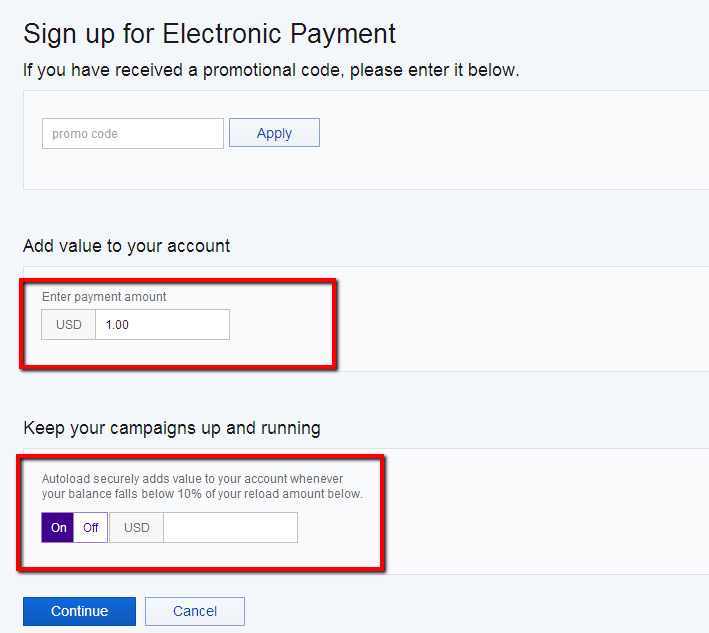
Follow the prompts to fund your account.
Yahoo Gemini Reporting Options
From the Reporting screen, you can access reports for your campaigns, ad groups (Mobile Search), ads, and keywords (Mobile Search).
However, there’s also a 7-Day Performance Report available within the Campaigns tab. This report will show you:
- The number of times your ads were shown to users.
- The number of times users have clicked on your ads.
- The install-click rate is the number of installs divided by the number of clicks you received. It indicates how often users install your app after they clicked through the ads. Try comparing it to the install-impression rate to see how effective you ads are overall.
- The amount you have spent for the user actions that you have achieved. Please note that this should be used as guidance only as the amount you are charged may differ.
- The average cost per click is the average amount you have paid for each click. Compare trends by selecting between the two drop-downs.
In the Reporting tab, information is stored for 90 days and includes impressions, clicks and CTRs broken down by:
- Campaigns
- Ad Groups – Migrated Mobile Search Only
- Ads
- Keywords – Mobile Search Only
Note, these reports are not real-time; there is an 8-hour lag between impressions and reporting in the interface.
Scheduling & Exporting Reports
You can set up automatic reports using the Schedule button in the Reporting tab. Choose to have daily or weekly CSV reports sent to your email.
You can export a report any time by clicking Export within the Reporting tab, selecting CSV, and either opening the .zip file or saving it to your computer.
Bid Landscape Reports
The Bid Landscape report is available in the Reporting tab by clicking Bid Landscape. This is a graph that shows you how changing your bid changes the number of clicks and impressions you would have received over a given timeframe. It’s designed to help you optimize your bidding strategy by projecting the effect of variances in your bids.
Good-to-Know Tips on Yahoo Gemini
Here are a few tips/facts that will help you better navigate the Yahoo Ad Manager and work with their native ad offerings:
- Yahoo recommends that you have fewer than 100 active ad creative at any given time, but there’s no actual limit.
- The Yahoo native ads platform is compatible with IE 9 or higher, Chrome, Firefox and Safari.
- You can have multiple accounts associated with the same Yahoo ID and toggle between accounts.
- You can use Manage Users to create new user profiles and assign levels of administrative privileges to them.
- You can delete items in bulk from the main table for paused campaigns, ad groups (Mobile Search), ads, and keywords (Mobile Search).

Yahoo Gemini, designed to offer advertisers a unified marketplace for mobile search and native advertising, is available now through the self-serve Yahoo Ad Manager. New ad formats, placements and platform features will be released as the service evolves.
Are you going to give Yahoo Gemini a shot? Share your thoughts or experience with it in the comments!

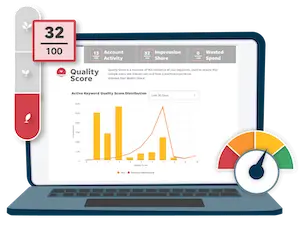







Comments
Please read our Comment Policy before commenting.